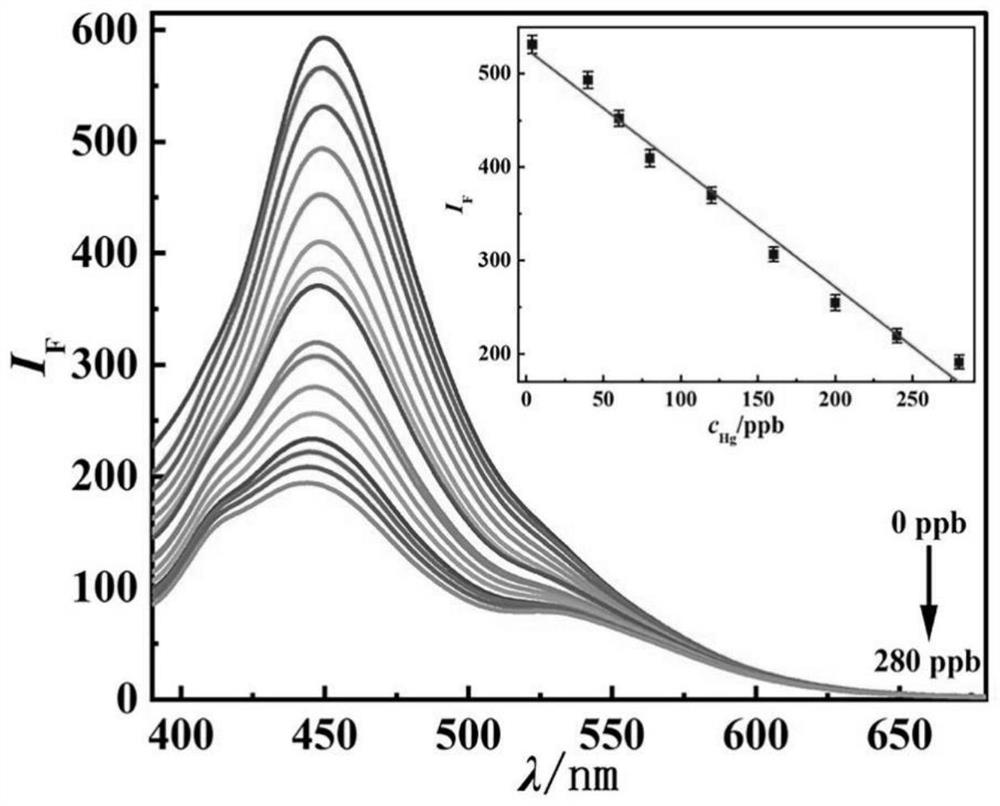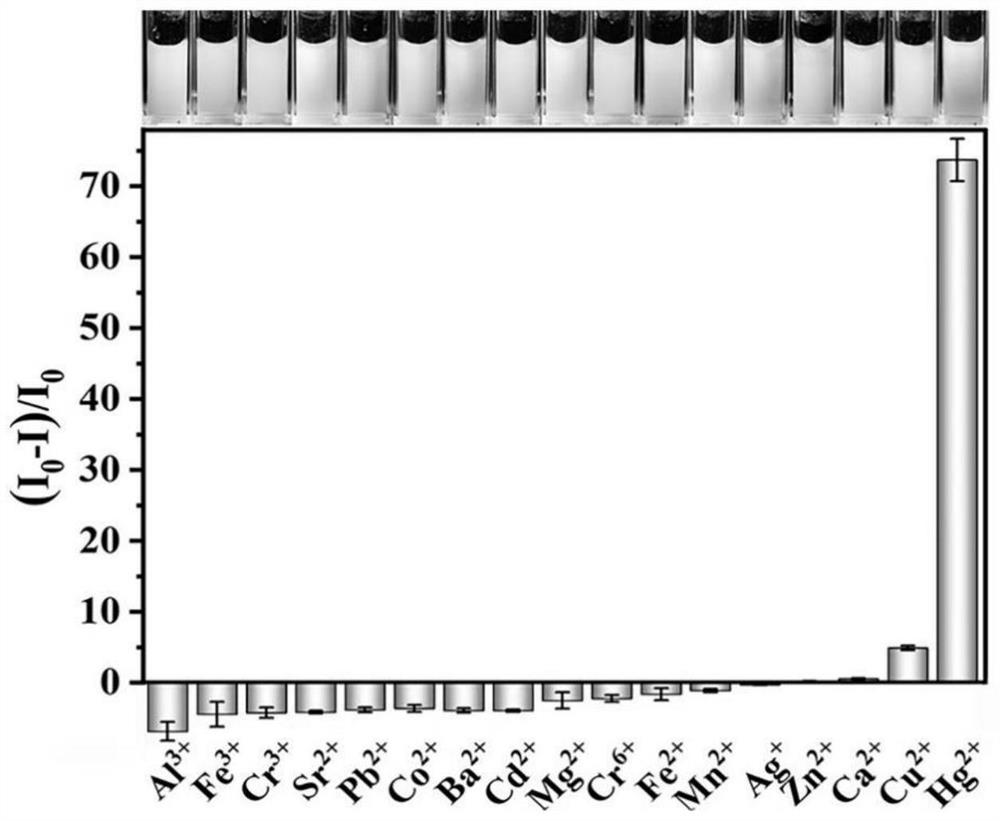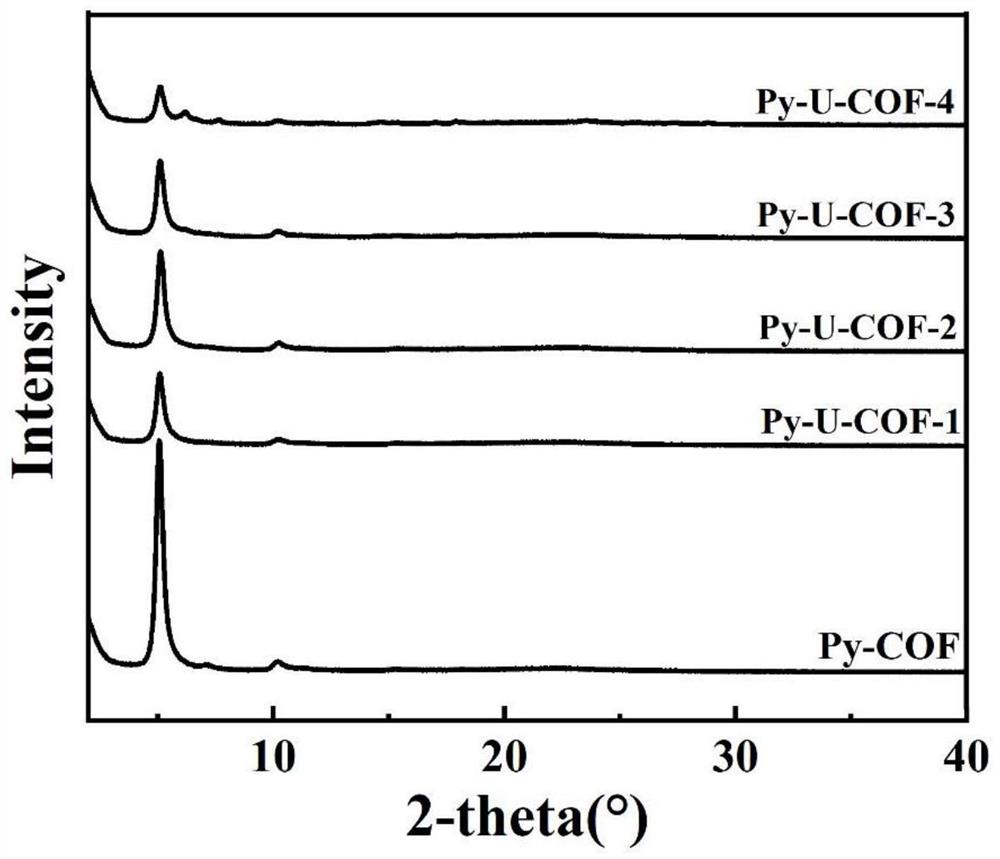One-step preparation method of pyrimidine group-containing COFs (covalent organic frameworks) and application of pyrimidine group-containing COFs in mercury (II) detection
A pyrimidine-based, fluorescent detection technology, applied in the field of material preparation technology and analytical chemistry, can solve the problems of poor water solubility, time-consuming, and complicated preparation steps of COFs, and achieve the effects of saving time, accurate and reliable methods, and reducing reagent loss
- Summary
- Abstract
- Description
- Claims
- Application Information
AI Technical Summary
Problems solved by technology
Method used
Image
Examples
Embodiment 1
[0042] Synthesis of Py-U-COF-1:
[0043] The preparation method of Py-U-COF-1 includes the following steps: adding 30.94mg 1,3,6,8-tetrakis(4-formaldehyde phenyl)pyrene, 25.50mg 1,3, 6,8-Tetrakis(4-aminophenyl)-pyrene, 2.54 mg 5-aminouracil, 1.0 mL o-dichlorobenzene, and 1.0 mL n-butanol. After dispersing in a sonicator for 20 minutes, 0.2 mL of 6 mol / L acetic acid was added to the glass tube as a catalyst and then sonicated for 15 minutes. The reaction solvent was quickly frozen in liquid nitrogen, the glass tube was sealed with a hydrogen flame under vacuum conditions, and then placed at 120° C. for constant temperature reaction for 3 days. After the reaction, the unreacted monomers were eluted with N,N-dimethylformamide, tetrahydrofuran and dichloromethane, filtered and dried in an oven at 60 °C for 12 h to obtain Py-U-COF-1.
Embodiment 2
[0045] Synthesis of Py-U-COF-2:
[0046] The preparation method of Py-U-COF-2 includes the following steps: adding 30.94mg 1,3,6,8-tetrakis(4-formaldehyde phenyl)pyrene, 19.84mg 1,3, 6,8-Tetrakis(4-aminophenyl)pyrene, 7.63 mg 5-aminouracil, 1.0 mL o-dichlorobenzene and 1.0 mL n-butanol. After dispersing in a sonicator for 20 minutes, 0.2 mL of 6 mol / L acetic acid was added to the glass tube as a catalyst and then sonicated for 15 minutes. The reaction solvent was quickly frozen in liquid nitrogen, the glass tube was sealed with a hydrogen flame under vacuum conditions, and then placed at 120° C. for constant temperature reaction for 3 days. After the reaction, the unreacted monomers were eluted with N,N-dimethylformamide, tetrahydrofuran and dichloromethane, filtered and dried in an oven at 60 °C for 12 h to obtain Py-U-COF-2.
Embodiment 3
[0048] Synthesis of Py-U-COF-3:
[0049] The preparation method of Py-U-COF-3 includes the following steps: adding 30.94mg 1,3,6,8-tetrakis(4-formaldehyde phenyl)pyrene, 14.17mg 1,3, 6,8-Tetrakis(4-aminophenyl)pyrene, 12.71 mg 5-aminouracil, 1.0 mL o-dichlorobenzene, and 1.0 mL n-butanol. After dispersing in a sonicator for 20 minutes, 0.2 mL of 6 mol / L acetic acid was added to the glass tube as a catalyst and then sonicated for 15 minutes. The reaction solvent was quickly frozen in liquid nitrogen, the glass tube was sealed with a hydrogen flame under vacuum conditions, and then placed at 120° C. for constant temperature reaction for 3 days. After the reaction, use N,N-dimethylformamide, tetrahydrofuran and dichloromethane to elute the unreacted monomer, filter and dry in a 60°C oven for 12h to obtain Py-U-COF-3.
PUM
 Login to View More
Login to View More Abstract
Description
Claims
Application Information
 Login to View More
Login to View More - R&D
- Intellectual Property
- Life Sciences
- Materials
- Tech Scout
- Unparalleled Data Quality
- Higher Quality Content
- 60% Fewer Hallucinations
Browse by: Latest US Patents, China's latest patents, Technical Efficacy Thesaurus, Application Domain, Technology Topic, Popular Technical Reports.
© 2025 PatSnap. All rights reserved.Legal|Privacy policy|Modern Slavery Act Transparency Statement|Sitemap|About US| Contact US: help@patsnap.com



